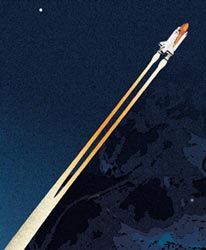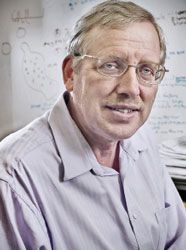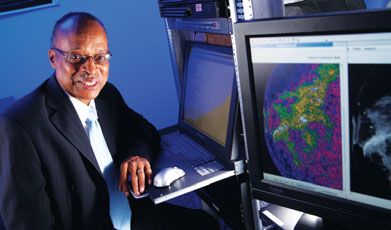Publication
Article
Oncology Live®
From Rockets to Radiology: How NASA Boosts Cancer Research
Author(s):
The technology that enables astronomers to detect eversmaller objects across evergreater distances through ever-heavier interference has found a ready audience among researchers dreaming of adapting it for cancer detection

The technology that enables astronomers to detect eversmaller objects across evergreater distances through ever-heavier interference has found a ready audience among researchers dreaming of adapting it for cancer detection.
A computer that “looks” at many different photographs will typically “see” each as the exact same thing—abstract art. The colored pixels that evoke 3-dimensional (3D) reality in human imagination never strike a hyper-rational machine as anything but what they really are: digitally stored ones and zeros. James C. Tilton, PhD, first considered this problem more than a quarter-century ago and decided to help solve it by writing software that would allow computers to compare pixels and guess which ones went together. Such a process, at its simplest, now allows programs like Photoshop to spot individual objects, but Tilton wanted to go further.
Since then, working largely alone in his office at NASA’s Goddard Space Flight Center in Greenbelt, Maryland, the computer engineer has devised a still-evolving program that analyzes photo pixels and groups them into related segments. Scientists have since used Tilton’s software to improve the accuracy of ice and snow maps and fi nd archaeological ruins under dense jungle. Now they’re testing its ability to detect breast cancer. “I was so focused on using this to analyze satellite photos that I never considered medical applications,” Tilton said. “Then I heard the idea, and it just made perfect sense. It’s largely the same task.”

James C. Tilton, a NASA computer engineer, develops imaging software.
Exploring Space. Fighting Cancer.
While those challenges might seem at first glance to be worlds apart, the technology that enables astronomers to detect ever-smaller objects across ever-greater distances through ever-heavier interference has found a ready audience among researchers dreaming of adapting it for cancer detection.
Such dreams have sent a steady stream of technology from the rocket ship to the cancer clinic over the decades. While none of NASA’s inventions has revolutionized oncology, many have found lasting homes at hospitals. And new products always await testing.
“NASA does so much basic research that its ideas affect everything from the design of knee braces to the efficient scheduling of shift workers,” said Daniel Lockney, a spokesman for the Office of the Chief Technologist at NASA. “Medical research is not something that NASA sets out to do, but technology developed here has certainly found medical applications, particularly in imaging.”
Through the Astronomy Looking Glass
The link between astronomy and medical imaging goes way back. Historians believe that one man, the German eyeglass maker Hans Lippershey, may well have invented both the telescope and the microscope in the late 1500s.
NASA researchers didn’t invent any major medical imaging devices, but their work has improved many existing devices, a review of agency reports indicates.
When mammography first became popular in the late 1960s, doctors took several exposures of each breast to guarantee good images. NASA scientists helped to change that when they figured out that a solar cell, placed directly under x-ray film, could indicate when that film had received just enough radiation.
This discovery helped researchers elsewhere devise practical means for single-exposure mammography, an improvement that saved women time, money, discomfort, and, most importantly, contact with radiation.
Astronomers also helped develop some of the sensor technology that took medical imaging from film to computers, a jump that has boosted image quality and allowed specialists in one part of the world to diagnose patients in another.
The digital transition also made it theoretically possible for machines to help people interpret medical images. A computer that somehow used software to overcome its visual handicaps could analyze far more image data, far more exactly, than any human being ever could.
Entrepreneur Seeks Imaging Advance
With this dream in mind, some would-be medical revolutionaries began writing software from scratch.
Fitz G. Walker Jr, on the other hand, stumbled accidentally across Tilton’s software at one of NASA’s technology licensing fairs.
The program’s ability to accurately distinguish among different geological features, even those of almost identical coloring, suggested a program that could also extract huge amounts of data from the indistinct silver monotone of a typical mammogram.
"Medical research is not something that NASA sets out to do, but technology developed here has certainly found medical applications, particularly in imaging."
—Daniel Lockney, NASA
Walker, an entrepreneur who has worked in several computer-related occupations, gained exclusive rights to the patented technology through NASA’s Innovative Partnerships Program in 2003, founded a company called Bartron Medical Imaging Inc in Largo, Maryland, and started customizing the software for medicine.
Since then, 5 Barton programmers have been hunched over their computers while Walker’s family and friends have spent about $1.5 million funding the operation.
Much remains to be finished, particularly software for 3D images, but Bartron has won its first commercial victory. In July, the FDA approved the company’s application to market MED-SEG™ for storing medical images for hospitals and other clients. Now Barton can earn revenue while it runs the tests needed to see whether its technology advances doctors’ ability to read mammograms and other images.
“It will probably take me 2 years to complete the tests that will demonstrate this to the FDA’s satisfaction, but from what I’ve seen, I believe this technology will improve radiologist interpretive skill anywhere from 27% to 67%,” said Walker, who is working with researchers at the University of Connecticut on diagnostic testing. “Machines can simply analyze these images in ways that human eyes cannot.”

Entrepreneur Fitz G. Walker Jr is partnering with NASA.
New Environment for Tumor Testing
Imaging technology isn’t the only area where NASA has contributed to oncology. The sheer volume of NASA research generates a steady stream of gizmos that fi nd unexpected uses in every conceivable corner of the world, including medical research.
A device that NASA developed decades ago to study the effect of low gravity on living tissue, for example, may help earthbound humans fight cancer and other diseases.
NASA’s microgravity bioreactor is a cylindrical container that uses a complex rotating movement to simulate a low-gravity environment. To the untrained eye, it looks like a next-generation rotisserie cooker. To researchers, it looks like an ideal place for growing tumors and other kinds of cells.
Lab-grown tumors have traditionally borne little resemblance to cancers that develop inside animals. They grow slowly and come out flat as pancakes, which limits their practical use.
Tumors grown in NASA bioreactors, on the other hand, grow many times faster and develop normal 3D structures.
The structural changes entice researchers for obvious reasons. The greater the resemblance between lab-grown tumors and their human counterparts, the more researchers should be able to learn from experimenting with the tumors they create.
And the faster those tumors grow in labs, the easier it will be for researchers to test new theories.
NASA began using its bioreactor to study tumors about 15 years ago and brought a handful of academic researchers into the project several years after that. Such devices are currently spinning away at more than 100 labs, growing countless tissue types that range from cancerous tumors to the stem cells that may someday treat them.
NASA, meanwhile, has moved from terrestrial bioreactors to devices designed for use aboard the International Space Station. The machine and the environment combine to reduce gravity further and spur some cultures to grow at incredible rates.
Experiments that could take months on Earth can take just hours on a bioreactor orbiting 220 miles above the ground, a difference so profound that NASA believes it will be cost-efficient to do many experiments in space, despite the expense of blasting materials there.
Studying Nanotubes for Immunotherapy
As astronauts up there continue to explore microgravity’s unexpected effects on culture growth, researchers down here hope they’ve found an even more unexpected use for some very tiny technology.
Scientists at the NASA Jet Propulsion Laboratory in Pasadena, California, began building microscopic particles called carbon nanotubes for several mechanical purposes.

Mammogram image before MED-SEG processing, left, and afterward, right.
Oncologists at a nearby hospital got wind of the project and saw the opportunity to test an idea for using minuscule particles to fight glioblastoma, the most prevalent and the most deadly form of malignant brain tumor. Glioblastoma attacked roughly 36,000 Americans from 2004-2007, with 5-year survival rates ranging from 20% to <1 year depending upon age at diagnosis, according to the most recent National Cancer Institute report (J Natl Cancer Inst. 2011;103:1-23).
Researchers at the City of Hope National Medical Center in Duarte, California, saw a possible immunotherapy strategy for these tumors in nanotubes.
They figured they could bind the drugs they were using to carbon nanotubes and inject small doses of the resulting mixture right around cancer sites. The nanotubes, they hoped, would increase the initial immune response and keep the injected materials near the cancers far longer—giving the immune system time to develop a specific defense against the cancer.
Experiments on mice show that without the nanotubes, such localized injections shrink only a small percentage of tumors. With the nanotubes, they fully cure 60% to 70 % of the tumors.
“These are extremely good results and what makes us particularly excited is that the treatment keeps working no matter how we vary the experiment,” said Behnam Badie, MD, chief of the Department of Neurosurgery at City of Hope.
But Badie tempers his optimism with caution. “Treating mice is very different than treating humans. We’re just at the beginning.”
Bright Hopes Often Fade
Precedent explains Badie’s caution. He and researchers at NASA know that experimental cancer-fi ghting tools often fail to deliver—even when the ideas are sound and the technology is revolutionary.
NASA produced a steady stream of such breakthrough technology throughout the 1990s, when it kept making radical improvements to imaging systems that use computer chips to sense heat.
These systems, designed for core NASA missions such as tracking rockets and probing space, also promised to find cancer by spotting the heat from the extra blood supply that surrounds tumors.
NASA licensed the technology to an upstate New York company called OmniCorder Technologies, and, in 1999, OmniCorder gained FDA approval to begin using its BioScanIR system to diagnose several types of cancer. A steady stream of press releases emerged over the next few years, announcing new customers, many of which ranked among the world’s most prestigious hospitals.
Researchers know cancer-fighting tools often fail to deliver—even when the ideas are sound and the technology is revolutionary.
After 2006, the news slowed to a trickle and eventually stopped. The company, which had by then renamed itself Advanced BioPhotonics, fi red all its employees and closed its doors in early 2008, according to documents fi led with the US Securities and Exchange Commission.
Another NASA idea that made news much more recently as a cancer-fi ghter also appears to have fallen by the wayside.
An “electronic nose” that was developed to monitor air quality at the International Space Station got scientists excited about sniffi ng out waste products emitted by tumors. The ENose could detect contaminants at such low concentrations—sometimes 1 part per million—that it might be able to spot tumor waste long before traditional imaging could spot the tumors that produced it.
But experiments at City of Hope did not pan out despite early promise. The hospital dropped ENose a few months ago, said Shawn Le, a spokesman for the hospital.
Discoveries Spur New Ventures
Still, as some technologies fade, new ones rise, inspiring new hope.
Along the Gulf Coast of Mississippi, researchers are tinkering with yet another imaging technology, one that can see things that are completely invisible to humans.
Our brains recognize things, in large part, by memorizing how light refl ects off different objects. Tennis balls refl ect bright yellow light, but not other colors, helping us distinguish them from baseballs, which reflect white light.
Many materials refl ect energy in signature patterns, but humans cannot see these. For one thing, our eyes simply cannot detect wavelengths outside that area of the electromagnetic spectrum we call visible light. For another, we cannot distinguish at a glance between an object that refl ects one particular shade of, say, blue from one that refl ects an almost identical shade. Not so for machines.
We can build machines that detect all types of electromagnetic waves, and, in theory, we can use those machines to discover the signature refl ective patterns of all sorts of materials, from the new paint in forged art to the malignant cells inside a tumor.
Having found the signature pattern of each, we could then teach machines to recognize when those patterns occur.
Themis Vision Systems is one of several companies that hopes to cash in on the promise of these “hyperspectral” signatures. Much of its technology comes from NASA, where founder Mark Allen Lanoue worked before starting Themis.
Lanoue believes that hyperspectral technology will likely revolutionize cancer detection, starting with melanomas. If all goes according to plan, Themis-powered devices will scan biopsies and instantly distinguish benign from malignant cells.
Lanoue, like most high-tech entrepreneurs, radiates optimism, but even he doesn’t believe that his 9-man company has the resources to bring cancer diagnostics or other tools to market. He plans to work with larger companies that envision medical uses for hyperspectral imaging.
“Multibillion-dollar drug companies sometimes struggle to fi nance FDA trials, so I don’t have any dreams of going this alone,” Lanoue said.
Only time will tell if Themis, Bartron, or any other of NASA’s current partners will deliver a breakthrough product, but one thing is for sure. The space agency’s ongoing imaging innovations will continue to tantalize oncologists and other medical researchers— keeping astronomy and oncology connected, just as they have been since the time of Hans Lippershey.









